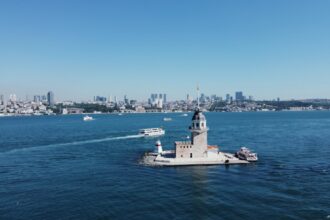The V-2 rocket, a groundbreaking achievement in the realm of military technology, traces its origins back to the tumultuous period of the 1920s and 1930s in Germany. The seeds of this revolutionary weapon were sown in the aftermath of World War I, when the Treaty of Versailles imposed severe restrictions on German military capabilities. Despite these limitations, a group of visionary engineers and scientists began to explore the potential of rocketry.
Among them was Hermann Oberth, whose writings inspired a generation of rocket enthusiasts, including Wernher von Braun. The fascination with space travel and the mechanics of propulsion laid the groundwork for what would eventually become the V-2. As the political landscape shifted in Germany during the rise of the Nazi regime, the government recognized the potential of rocketry for military applications.
The urgency to develop advanced weaponry led to increased funding and support for research in this field. By the late 1930s, the German military had begun to take a keen interest in the development of long-range missiles, setting the stage for the V-2 project. This initiative was not merely a response to military needs; it was also a manifestation of national pride and technological ambition, aiming to showcase Germany’s engineering prowess on the world stage.
Key Takeaways
- The V-2 rocket was developed by Nazi Germany during World War II as the world’s first long-range guided ballistic missile.
- Wernher von Braun, a German aerospace engineer, played a key role in the development of the V-2 rocket and later became instrumental in the American space program.
- The V-2 rocket had a range of 200 miles and could carry a 2,200-pound warhead, making it a significant threat during World War II.
- The V-2 rocket had a devastating impact on World War II, causing widespread destruction and civilian casualties, particularly in London and Antwerp.
- The V-2 rocket’s technological advancements and the expertise of its developers laid the foundation for modern rocket technology and space exploration.
Wernher von Braun and the Development of the V-2
Wernher von Braun emerged as a pivotal figure in the development of the V-2 rocket, combining his engineering expertise with a visionary outlook on space exploration. Born in 1912 in Germany, von Braun displayed an early fascination with rockets and space travel. His academic pursuits led him to study engineering and physics, where he honed his skills in propulsion and aerodynamics.
By the time he joined the German Army’s rocket program in the late 1930s, he had already established himself as a leading figure in rocketry. Under von Braun’s leadership, the V-2 project gained momentum. He assembled a team of talented engineers and scientists at Peenemünde, a remote research facility on Germany’s Baltic coast.
Von Braun’s vision extended beyond mere military applications; he dreamed of using rockets for space exploration. However, during World War II, his focus remained on perfecting the V-2 as a weapon capable of striking distant targets with unprecedented accuracy.
The Technical Specifications of the V-2 Rocket

The V-2 rocket represented a significant leap in missile technology, boasting impressive technical specifications that set it apart from its predecessors. Standing at approximately 14 meters tall and weighing around 13 tons, it was powered by a liquid-fueled engine that utilized a combination of alcohol and liquid oxygen as propellants. This innovative propulsion system allowed the V-2 to reach altitudes of over 180 kilometers and speeds exceeding 5,700 kilometers per hour, making it the world’s first long-range guided ballistic missile.
The design of the V-2 was characterized by its aerodynamic shape, which minimized drag and maximized stability during flight. Its guidance system employed gyroscopic stabilization and an inertial navigation system, enabling it to follow a predetermined trajectory with remarkable precision. The warhead could carry a payload of approximately 1,000 kilograms, delivering devastating explosive power upon impact.
These technical advancements not only showcased German engineering capabilities but also laid the foundation for future developments in missile technology.
The Impact of the V-2 on World War II
| Aspect | Impact |
|---|---|
| Casualties | Approximately 9,000 killed and 12,000 injured |
| Psychological impact | Caused fear and terror among civilians in London and Antwerp |
| Technological advancement | Contributed to the development of rocket technology |
| Strategic impact | Forced Allies to divert resources to counter the V-2 threat |
The introduction of the V-2 rocket into World War II marked a turning point in modern warfare. Deployed by Nazi Germany against Allied cities, particularly London and Antwerp, the V-2 was unlike any weapon seen before. Its ability to strike targets from great distances instilled fear among civilians and military personnel alike.
The psychological impact of these attacks was profound; they represented not just physical destruction but also a new era of warfare where technology could reach deep into enemy territory without warning. Despite its technological advancements, the V-2 program faced significant challenges during its operational deployment. The production process was hampered by resource shortages and Allied bombings of manufacturing facilities.
Nevertheless, between 1944 and 1945, thousands of V-2 rockets were launched, causing considerable damage and loss of life. The weapon’s effectiveness demonstrated the potential for guided missiles in warfare, prompting military strategists to rethink conventional tactics and consider the implications of long-range strike capabilities.
Post-War Developments and the V-2 Rocket
Following World War II, the fate of the V-2 rocket took a dramatic turn as Allied forces captured key personnel and technology from Germany. Wernher von Braun and many of his colleagues were brought to the United States as part of Operation Paperclip, a secret program aimed at harnessing German scientific expertise for American military and space endeavors. This transition marked a significant shift in the trajectory of rocket technology, as former adversaries became instrumental in shaping future advancements.
In America, von Braun’s work on the V-2 laid the groundwork for subsequent rocket programs, including the Redstone and Saturn rockets. The knowledge gained from developing and deploying the V-2 was invaluable in refining propulsion systems, guidance technologies, and overall rocket design. As Cold War tensions escalated, these advancements would play a crucial role in both military applications and space exploration efforts.
The Legacy of the V-2 in Rocket Technology

The legacy of the V-2 rocket extends far beyond its immediate impact during World War II; it fundamentally transformed the landscape of rocket technology. As one of the first successful ballistic missiles, it set a precedent for future developments in guided missile systems. The engineering principles established during its design influenced subsequent generations of rockets, paving the way for more sophisticated systems capable of delivering payloads with precision.
Moreover, the V-2’s technological innovations laid the groundwork for space exploration initiatives that would follow in subsequent decades. The lessons learned from its development informed critical aspects of rocket design, including propulsion methods, aerodynamic shaping, and guidance systems. As nations around the world began to invest in their own space programs, they built upon the foundation established by early pioneers like von Braun and his team.
The V-2 Rocket’s Influence on Space Exploration
The influence of the V-2 rocket on space exploration cannot be overstated. As scientists and engineers sought to push beyond Earth’s atmosphere, they drew heavily from the knowledge gained during its development. The principles of rocketry that were refined through the V-2 project became essential components in launching satellites and human missions into space.
In particular, von Braun’s vision for space travel inspired ambitious projects such as Project Mercury and Project Apollo in the United States. The Saturn V rocket, which ultimately took astronauts to the Moon, was built upon many concepts pioneered by the V-2 program. This connection between military technology and space exploration highlights how wartime innovations can lead to peaceful advancements that benefit humanity as a whole.
The V-2 Rocket’s Role in the Space Race
As the Cold War unfolded, competition between superpowers intensified, culminating in what became known as the Space Race. The technological advancements initiated by the V-2 rocket played a crucial role in this rivalry between the United States and the Soviet Union. Both nations recognized that mastery over rocketry was essential not only for military superiority but also for demonstrating technological prowess on a global stage.
The Soviet Union’s successful launch of Sputnik in 1957 marked a significant milestone in this race, prompting an urgent response from American scientists and engineers who had been influenced by earlier developments like those stemming from the V-2 project. The race to achieve milestones such as human spaceflight and lunar landings was fueled by innovations rooted in wartime research, showcasing how past conflicts can shape future endeavors.
The V-2 Rocket’s Contribution to Missile Technology
The contributions of the V-2 rocket to missile technology extend well into contemporary times. Its design principles laid foundational concepts for modern ballistic missiles used by various nations around the world today. The advancements made during its development influenced not only military applications but also civilian technologies related to satellite launches and space exploration.
As nations continue to develop their own missile capabilities, they often reference or build upon concepts established by early pioneers like those involved with the V-2 project. This enduring legacy underscores how innovations born out of necessity during wartime can have lasting implications across multiple domains.
The V-2 Rocket’s Impact on Scientific Research
Beyond its military applications, the V-2 rocket significantly impacted scientific research by providing valuable data on atmospheric conditions at high altitudes. During its operational period, scientists utilized captured V-2 rockets for various experiments aimed at understanding atmospheric phenomena and conducting research related to aerodynamics. These experiments contributed to advancements in fields such as meteorology and physics while also informing future designs for both military and civilian rockets alike.
The Continued Relevance of the V-2 Rocket in Modern Times
Even decades after its initial deployment during World War II, the relevance of the V-2 rocket persists in modern discussions surrounding missile technology and space exploration initiatives. As nations grapple with issues related to defense capabilities and international security concerns, understanding historical precedents like those set by the V-2 becomes increasingly important. Moreover, ongoing advancements in aerospace engineering continue to draw inspiration from early rocketry efforts exemplified by projects such as those led by von Braun.
As humanity stands on the brink of further exploration beyond our planet—whether through missions to Mars or beyond—the legacy left behind by pioneers who developed technologies like those found within the V-2 remains an integral part of our journey into uncharted territories.
The Redstone rocket, a direct descendant of the German V-2 rocket, played a pivotal role in the early days of the American space program. For those interested in exploring more about the technological advancements and historical significance of the Redstone rocket, a related article can be found on the War Room website. This article delves into the intricate details of the rocket’s development and its impact on subsequent space exploration missions. To read more about this fascinating topic, visit the War Room’s article on the Redstone rocket.
WATCH THIS! 🪖How Stolen Nazis Built Cold War Power
FAQs
What is the Redstone Rocket V-2?
The Redstone Rocket V-2 was a ballistic missile developed by the United States during the Cold War era. It was based on the German V-2 rocket technology captured at the end of World War II.
When was the Redstone Rocket V-2 developed?
The development of the Redstone Rocket V-2 began in the late 1940s, with the first successful test flight taking place in 1953.
What was the purpose of the Redstone Rocket V-2?
The Redstone Rocket V-2 was initially developed as a ballistic missile for military use. It was later adapted for use in the space program and played a crucial role in launching the first American astronaut into space.
How was the Redstone Rocket V-2 used in the space program?
The Redstone Rocket V-2 was modified to become the Redstone missile, which was used to launch the first American suborbital and orbital flights, including the historic flight of Alan Shepard in 1961.
What was the significance of the Redstone Rocket V-2 in the history of space exploration?
The Redstone Rocket V-2 played a pivotal role in the early days of the American space program, demonstrating the capability of launching humans into space and paving the way for future space missions.




